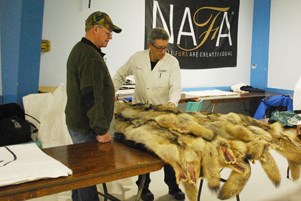With warm weather persisting into December through much of Manitoba, including the north, and the worldwide market for fur softer than it’s been in the past couple of years, it was literally and figuratively tough sledding for fur trappers who bring their pelts to the annual Thompson fur tables, which were held Dec. 18-19 this year at St. Joseph’s Hall in Thompson.
“It’s the lowest turnout we’ve ever had in the past many years,” said Ron Spence of Nisichawayasihk Cree Nation, president of the Manitoba Trappers Association, which organizes the event, on the morning of Dec. 18.
One of the reasons was the weather.
“It’s not that they don’t want to get out, it’s the safety factor,” says Spence. “For me, personally, I have to go three traplines to get to mine. If the first trapper can not get out on his trapline the rest of us can’t get out and we don’t want to risk our lives with the dangers of the travel with the lack of ice.”
The weather also impacts the quality of the fur, he says.
“The primeness of the fur is not the greatest either,” said Spence. “If we get cold weather earlier in late fall, of course, freeze-up, travel is good, the fur is very prime early and the guard hairs, the under hairs, it’s a fine product and the market is really good. That plays a big factor.”
Trapper Ron Thomas attested to the tough conditions.
“It’s been hard on the ice,” said Thomas, who’s from Brochet but lives in Lynn Lake and did his trapping on a friend’s trapline near Wolverine Lodge, not far from Lynn Lake. “It’s barely frozen, kind of dangerous. I didn’t trap that much this year, just a tiny bit. Then my skidoo broke down and it’s still out there in the lake.”
Thomas, who traps mainly to earn some extra money to buy Christmas gifts for his grandchildren, said his prey wasn’t taking the bait, either.
“There’s a lot of fur signs out there, marten tracks and whatnot, but they’re not going in for some reason,” he said, having harvested just 22 marten this year along with a few foxes and mink. “They just go there and run away. They’re coming around but they’re not hungry or it’s too warm. I don’t know.”
Compounding that is a soft market, says David Bewick of North American Fur Auctions, one of the buyers in Thompson.
“We’re relying on Russia right now and Russia’s pretty much, I wouldn’t say non-existent, but a very small participator in the market this year,” Bewick said. “China’s slowed down. There’s lots of inventory sitting in China. Retail’s been a little slow. North America actually has probably picked up a little bit. It’s getting a little better but it’s not a huge player yet. They’re more into the trimming than into the garments. Western Europe is actually a little better than it has been and that’s more trimming. Korea’s probably slowed down a little bit. It all just kind of adds up.”
That said, the outlook was not all gloom and doom.
“The market has softened quite a bit since last year, although this section of marten should do OK,” Bewick said. “We should be able to get fairly good prices. We also have the advantage of the exchange [rate] this year, which is probably another 10 per cent over last year. That’ll help us a bit. The bundles are smaller, guys don’t have as much fur as they had a year ago and it’s all a reflection of the conditions and the market conditions right now.”
Despite the fact that the trapping is tougher and the returns aren’t as great as they were a few years ago, Bewick says its important that trappers continue to get out in the bush.
“The worst thing that can happen is if guys think, ‘Well, the prices are bad I’m not going to trap this year,’” Bewick says. “If everybody had that attitude we wouldn’t have any fur to sell. What would happen then? You’ve got to trap it to promote it and then hopefully get the market stimulated. It’s important that they don’t lose that thought. They’ve got to keep trapping if they want to be able to promote it and get the prices back.”
Spence says that for him, trapping isn’t so much about money as it is about tradition, so he’ll do it regardless of prices.
“I was raised by my grandparents in the trapline, fish camps and that’s why I do it,” he said. “I don’t make money. My helpers that go out, they make money because I’m the one that has all the equipment and they don’t so I do it for them. For me, I just do it for the lifestyle, the love of it and being out there in the wilderness and the bush, that’s the key.”
Thomas says he probably wouldn’t do the small amount of trapping he does if he couldn’t make a profit off it.
“It’s all for the money,” he said, laughing, before admitting that he does have a sentimental side. “I do love trapping. I was born and raised in the bush. My dad always did that for a living. He’d be gone in the fall and never see him until before Christmas. He’d be out there all winter.”
Still, Thomas, who’s trapped every year for the past 30 years, will likely be the last one in his family to continue the tradition.
“My kids are all full-grown now,” Thomas says. “They don’t know how to work the trap. I never taught them how to trap. They were always in school.”




